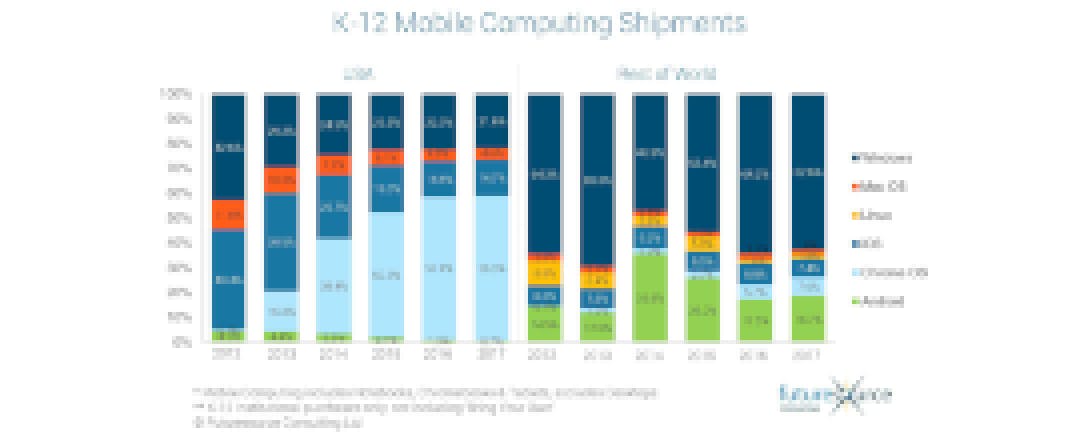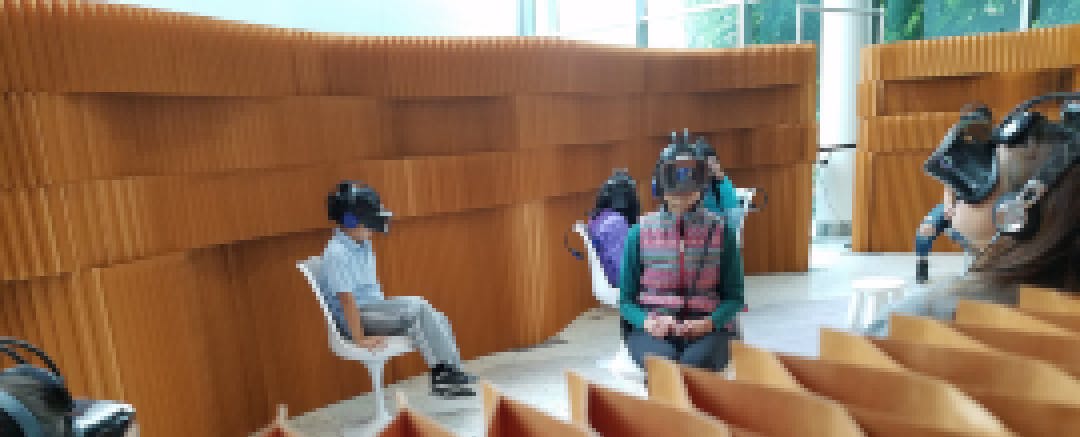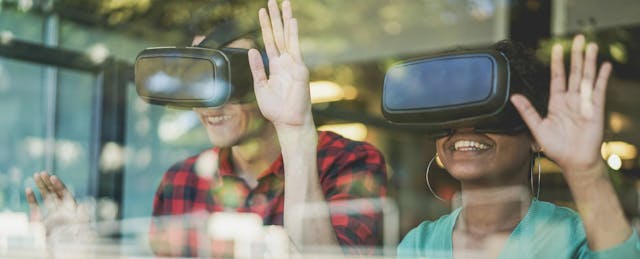One overused catchphrase in education is that learning should be “student-centered.” But what if we took that to its logical conclusion and also made it the goal of our education technology predictions?
We’d need to consider not just what technology products students are exposed to in the classroom, but also across the rest of their lives. Especially if those students are teens, within sight of leaving K-12 and moving into higher education.
Yes, teens. Messy, motivated, tech-drenched 15 year-olds, the high school sophomores of today who will be entering college or the workforce in 2022, a mere three years from now. Not quite enough time for our robot overlords to overtake us, but both distant and soon enough to make us wonder.
What will these teens expect of tech based on their current experiences? You can extrapolate by drawing converging lines from K-12 education technology and home consumer technology to see how they might overlap and intersect. Those interactions look a lot different than just evaluating consumer or edtech trends in isolation.
The Cloudscape: Floating in a Sea of 1s and 0s
For background, just consider the previous decade of their lives. They went into first grade when Apple was rolling out the first iPad, in 2010. A year later, in their second grade, Google launched the first Chromebooks. This means they know a K-12 where the promise of mobile 1:1 school computing is becoming a reality.
More important, these kids are way beyond the tired term “digital natives.” If you want to be picky about it, there’s no one under the age of 30 who has not grown up with the internet. After all, the first web browser was introduced in 1993, when today’s three-decade-old adult was in preschool.
The 15-year-old today is more a sibling of cloud computing, of apps that are available from any screen, of mobile devices in many sizes and form factors that go beyond last century’s laptops. Being connected, as is required to get iPads and Chromebooks up and running, is assumed.
Two other external factors also are at play in this teen-centric cloudscape.
First is the evolving nature of education technology. It’s hard to make a case that there is still a separate edtech industry. Nearly every education “product” that a teen or teen’s teacher touches today has either a digital component or alternative. It’s not like 40 years ago in the late 1970s when a single Apple II in the back of the classroom had explorers endlessly dying of dysentery on the Oregon Trail.
Second is the reality of what I call tech compression. There used to be a much greater separation between the worlds of consumer technology and education technology. It was, in essence, a time lag: a consumer tech product would be introduced and, if worthy, it would be about a decade before that product would start showing up in classrooms in any numbers.
There was a very obvious downside. Any student or educator walking into a tech-lagged classroom effectively stepped back in time when they entered. But the less-appreciated upside was that this slowness of centralized school evaluation and procurement could help prevent mis-purchases, of buying into a fad. The consumer market got to do the vetting before a shipment ever arrived at a district loading dock.
However, this lag began to erode when the rise of cloud computing made it possible for edtech startups to flood the market with educational applications, the expansion of broadband internet gave those apps an easy distribution channel into campuses, and an increasing number and variety of mobile devices provided them an in-school abode. Not just that, but outside of schools tech was increasingly pervasive and familiar. Add to that multiple avenues of adoption—that is, teachers bringing in tech, not just the central district office—and the tech lag compressed.
What had once been a decade from consumer introduction to classroom adoption shrank to two-to-three years. If that.
The protective effect of the earlier delay in preventing fad purchases may now be largely gone. But at the same time, teachers and teens can now walk into many schools seamlessly, with their powerful consumer tech intact. This isn’t true in all schools, especially in hard-to-cheaply-connect rural areas, despite loudly touted progress. Though EducationSuperhighway estimated last October that 40.7 million new students have been connected to high-speed access since 2013, and 98 percent of school districts now meet the Federal Communications Commission’s 100 kpbs/student goal for internet access, there remain 2.3 million more students left to connect.

So today’s 15-year-olds are floating in a cloud of digital support infrastructure, suspended a bit more firmly outside of school but not necessarily flat on their faces on campus anymore, either.
What edtech and consumer trends will be significant for when a teen leaves high school?
A trend, in this case, is a series of crossover developments that have staying power. It doesn’t have to be dominant today, but it needs to show the ability to persist, grow and not be a transient fad. It should also be supported by data and demonstrable behaviors.
Let’s pick three. Not the only three, but a significant three, for three years from now.

1. Chromebooks, Windows 10, and Apple (uh oh)
The rise of Chromebooks will come as no surprise to anyone who has followed the intense increase in popularity of the inexpensive notebooks in classrooms. In 2017—the last full year for which it publicly released detailed numbers—Futuresource Consulting estimated that Chromebooks had 58.3 percent of new mobile computing device shipments in U.S. K-12 education, a number that’s been rising since 2013 and has been above 50 percent every year since 2015. Reported percentages in 2018 appear to be similar, with Chrome OS achieving 60 percent of new U.S. shipments.
District officials I’ve spoken with love the centralized cloud management and the low price points (usually $200-300) that allows them to afford, as one put it, “spares.”
This Chrome OS share, of course, has made Microsoft angry. And determined. Outside of the U.S., Futuresource stats show Windows had 62.6 percent of the K-12 mobile computing shipment market in 2017, a percentage that’s been relatively stable for several years. But in the U.S., it was only 21.6 percent in 2017, and has been just north of 20 percent every year since 2015. Microsoft has countered by working with partners over the past two years to introduce sub-$300 Windows 10 devices into the U.S., and its own Surface Go device specifically aimed at the K-8 student market.
The big loser in this battle? Apple. The early rise of the iPad peaked in 2012-13 at about 40 percent of shipments. By the end of 2017, iOS was below 15 percent. Admittedly, this is new shipments only, not installed base. But with more high school students being exposed to an increasing number of Chromebooks first, and Windows 10 devices second, this presents a challenge to Apple.
Our 15-year-olds may have less affinity for pricey Apple computing hardware by the time they get to college.
One exception: upscale wearables and headphones. Moving to today’s consumer market, tech buyers are shifting to more functional and expensive fitness devices, and it’s here where Apple shines. A different Futuresource report notes Apple is the largest connected watch vendor with 20 million units shipped in 2018, followed by Fitbit and Fossil. Apple also does well in headphones. Futuresource reported that at the end of Q4 2018, Apple AirPods dominated the “true wireless” headphone category and average selling prices for headphones overall continued to climb faster than shipments as consumers looked for more features, like wireless and noise-cancelling models.
So Apple may wind up owning teen allegiance to wearable digital accessories, even as it loses hands-on loyalty in traditional laptops and tablets.

2. Extended reality is better together
If there’s a single tech category in education where the hype is on overdrive, it’s extended reality (XR). XR is really a reality continuum: at one end is “real” reality. That’s followed by augmented reality, or digital overlays on real environments. Then there’s mixed reality, commonly (but not always) thought of as virtual objects that can be manipulated on a real background. And at the other end is virtual reality, where both the objects and environment are digital.
Despite a lot of progress at every point along this spectrum, XR is a slow-moving edtech trend. The problem is that really good, realistic XR equipment is expensive, and there is a paucity of cohesive classroom curriculum that makes use of the technology.
There are attempts to jumpstart it. ZSpace, which has played in the AR/MR part of the spectrum for several years, launched its first Windows 10 laptops integrating its technology in 2018, supporting educational activities in which students wear special untethered glasses and use a stylus to manipulate 3D objects. Microsoft, perhaps best known for its several-thousand-dollar HoloLens headset, recently made a pledge that buyers of much lower-priced Windows Mixed Reality headsets would get 25 hours of free STEM curricula. Google, Acer, Lenovo, ClassVR and many others are trying to improve the in-school experience, with Futuresource estimating there were about 20 companies at London’s Bett edtech show in January showcasing AR/VR software or hardware.
Still, the reality is extending reality costs. Today’s 15-year-olds are most likely to only have computer lab-like experiences with XR by the time they graduate. Futuresource estimates more than 15 percent of U.S. schools will have a VR “class kit” by 2021.
But what about outside of school? Some of the same hardware challenges persist. There is still a need for cheap, high-resolution, fast-refreshing, fully wireless headsets—with a wide variety of great content. Yes, hard-core gamers will buy wired or expensive headsets, as will corporate training departments (Walmart has). But as a result of the affordability-quality conundrum, many consumers are getting their first high-end experience with virtual reality in VR arcades, reflecting a trend toward location-based social VR experiences that conceptually look an awful lot like … a school computer lab.
Barring some amazing, abrupt price cuts and technology improvements, the typical XR experience of the teen entering 2022 will be less Ready Player One and more group social outing.
3. Smart speakers are an AI gateway

Perhaps the biggest consumer tech trend that’s virtually invisible inside the K-12 classroom today is smart speakers. But you can anticipate it will have a major impact on teen tech expectations as our very verbal artificial intelligences overwhelm homes and hotels over the next three years—and become a gateway to an entirely new tech product category.
Consumer Intelligence Research Partners (CIRP) tallied the U.S. installed base of smart speakers by the end of 2018 at 66 million units, up from 36 million at the end of 2017. Of the speakers people own, Amazon Echo and its offspring are 70 percent of the installed base, Google Home is 24 percent, and Apple HomePod has 6 percent. Several market research firms track smart speakers and generally align on these proportions and the remarkable rate of growth.
In case it’s not obvious, Apple’s sole expensive HomePod isn’t doing as well as the full smart speaker families that Amazon and Google offer. Globally, according to other firms like Canalys, Apple is essentially a rounding error. Yet the number of people overall with more than one speaker has boomed: CIRP pegs it at 35 percent of owners, up from 18 percent a year ago.
While Futuresource earlier found that, as purchases of smart speakers have moved from early adopters to the mainstream, the most popular uses clustered more toward music and information. But increasingly, these speakers’ reach has also extended in a variety of ways.
Parents, for example, are being pitched the Echo Dot Kids Edition. Amazon’s Alexa Fund has invested in startups that target kids at home. One, Bamboo Learning, interactively teaches music theory and math. A second, Novel Effect, provides sound effects and background music for parents who read certain books out loud to their children at home. So even though understandable privacy concerns may keep smart speakers out of classrooms, kids at home are hearing voices for education.
Hotels and dorm rooms also are installing smart speakers as standard equipment. Amazon’s Alexa for Hospitality initiative is putting Echo Dots in several Marriott hotel brands, including Aloft, Westin, Autograph and St. Regis, complete with a list of commands they’re pre-programmed to handle. For college housing, St. Louis University is tucking Dots into every student residence after Arizona State University already did so for an engineering student residence.

Now add a screen. And when you do, you’ve edged into the territory of true virtual assistants. One Google Home Hub application in use at hotels in Las Vegas, San Francisco and New York City applies “Interpreter Mode” to provide visual and verbal real-time translation, of 27 languages, between non-English speaking hotel guests and staff.
Futuresource estimates that home consumer electronics of all kinds with built-in voice assistants shipped 119 million units worldwide in 2018. That’s expected to reach 504 million units by 2022, a compound annual growth rate of 43 percent.
While smart speakers may not be in a high school classroom for various good reasons, voice assistants are in every other part of a teen’s world. By 2022, they’re likely to be as much of a background expectation, as fast and pervasive internet access is today.
Not a straight line to the future
Taken together, just these three trends paint a different picture of what 2022’s incoming college freshman is likely to expect in tech, than just by focusing on what’s happening at the institution level.
Of course, a lot can upend even a three-year forecast. All it might take for wearables would be a major, health data-related privacy breach. It’s also not possible to predict a truly dramatic technology leap that could knock everything sideways, either by itself or in combination with a second new development, such as how smartphones and broadband internet intersected a decade ago.
But it’s instructive to focus less on the technology and where it’s used, and more on the individual that’s using tech across environments. Over the next three years, that average 15-year-old may know extended reality as a primarily social or group activity, will have less classroom exposure to Apple products, and be ready to accept smart speakers with their voice assistants as a transitional step to full virtual assistants.
And if you’re still wondering about our robot overlords and where they fit in—well, what do you think the current K-12 boom in coding is for?


